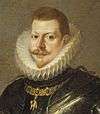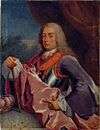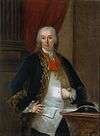List of Portuguese monarchs
| King of Portugal and the Algarves | |
|---|---|
|
| |
|
D. Manuel II | |
| Details | |
| Style | Style of the Portuguese sovereign |
| First monarch | D. Afonso I |
| Last monarch | D. Manuel II |
| Formation | 25 July 1139 |
| Abolition | 5 October 1910 |
| Residence | Royal residences in Portugal |
| Pretender(s) | Duarte Pio, Duke of Braganza |
The Monarchs of Portugal ruled from the establishment of the Kingdom of Portugal, in 1139, to the deposition of the Portuguese monarchy and creation of the Portuguese Republic with the 5 October 1910 revolution.
Through the nearly 800 years which Portugal was a monarchy, the kings held various other titles and pretensions. Two Kings of Portugal, Ferdinand I and Afonso V, also claimed the crown of Castile. When the House of Habsburg came into power, the Kings of Spain, and Naples, also became Kings of Portugal. The House of Braganza brought numerous titles to the Portuguese Crown, including King of Brazil and then Emperor of Brazil.
After the demise of the Portuguese monarchy, in 1910, Portugal almost restored its monarchy in a revolution known as the Monarchy of the North, though the attempted restoration only lasted a month before destruction. With Manuel II's death, the Miguelist branch of the House of Braganza became the pretenders to the throne of Portugal. They have all been acclaimed King of Portugal by their monarchist groups.
The monarchs of Portugal all came from a single ancestor, Afonso I of Portugal, but direct lines have sometimes ended. This has led to a variety of royal houses coming to rule Portugal, though all having Portuguese royal lineage. These houses are:
- The House of Burgundy (1139–1383)
- The House of Aviz (1385–1581)
- The House of Habsburg (1581–1640)
- The House of Braganza (1640–1910)
- The House of Braganza-Saxe-Coburg and Gotha (1853–1910)
House of Burgundy (1139–1383)
The Portuguese House of Burgundy, known as the Afonsine Dynasty, was the founding house of the Kingdom of Portugal. Prior to the independence of Portugal, the house ruled the feudal County of Portugal, of the Kingdom of Galicia. When Afonso I Henriques declared the independence of Portugal, he turned the family from a comital house to a royal house which would rule Portugal for over two centuries. When Ferdinand I died, a succession crisis occurred and Ferdinand's daughter Beatrice of Portugal was proclaimed queen and her husband John I of Castile proclaimed king by the right of his wife. Her legitimacy as a monarch is disputed.[1][2]
| Name |
Lifespan |
Reign start |
Reign end |
Notes |
Family |
Image |
|---|---|---|---|---|---|---|
| Afonso I
|
1109 – 6 December 1185 (aged 76) | 25 July 1139 | 6 December 1185 | Founder of the Kingdom of Portugal Son of Henry of Burgundy and Teresa of León, Counts of Portugal |
Burgundy | .png) |
| Sancho I
|
11 November 1154 – 26 March 1212 (aged 57) | 6 December 1185 | 26 March 1212 | Son of Afonso I | Burgundy | .png) |
| Afonso II
|
23 April 1185 – 25 March 1223 (aged 37) | 26 March 1212 | 25 March 1223 | Son of Sancho I | Burgundy | .png) |
| Sancho II
|
8 September 1209 – 4 January 1248 (aged 38) | 26 March 1223 | 4 December 1247 | Son of Afonso II | Burgundy | .png) |
| Afonso III
|
5 May 1210 – 16 February 1279 (aged 68) | 4 January 1248 | 16 February 1279 | Son of Afonso II | Burgundy | .png) |
Denis I
|
9 October 1261 – 7 January 1325 (aged 63) | 6 February 1279 | 7 January 1325 | Son of Afonso III | Burgundy | .png) |
| Afonso IV
|
8 February 1291 – 28 May 1357 (aged 66) | 7 January 1325 | 28 May 1357 | Son of Denis I | Burgundy | .png) |
Peter I
|
19 April 1320 – 18 January 1367 (aged 46) | 8 May 1357 | 18 January 1367 | Son of Afonso IV | Burgundy |  |
Ferdinand I
|
31 October 1345 – 22 October 1383 (aged 37) | 18 January 1367 | 22 October 1383 | Son of Peter I | Burgundy |  |
House of Aviz (1385–1580)
The House of Aviz, known as the Joanine Dynasty, succeeded the House of Burgundy as the reigning house of the Kingdom of Portugal. The house was founded by John I of Portugal, who was the Grand Master of the Order of Aviz. When King John II of Portugal died without an heir, the throne of Portugal passed to his cousin, Manuel, Duke of Beja. When King Sebastian I of Portugal died, the throne passed to his uncle, Henry I of Portugal. When Henry I died, a succession crisis occurred and António, Prior of Crato was proclaimed António I of Portugal. His legitimacy as a monarch is disputed.
| Name |
Lifespan |
Reign start |
Reign end |
Notes |
Family |
Image |
|---|---|---|---|---|---|---|
John I
|
11 April 1358 – 14 August 1433 (aged 75) | 6 April 1385 | 14 August 1433 | Illegitimate son of Peter I | Aviz |  |
Edward I
|
31 October 1391 – 9 September 1438 (aged 46) | 14 August 1433 | 9 September 1438 | Son of John I | Aviz |  |
| Afonso V
|
15 January 1432 – 28 August 1481 (aged 49) | 13 September 1438 15 November 1477 |
11 November 1477 28 August 1481 |
Son of Edward I | Aviz |  |
John II
|
3 March 1455 – 25 October 1495 (aged 40) | 11 November 1477 28 August 1481 |
15 November 1477 25 October 1495 |
Son of Afonso V | Aviz |  |
| Manuel I
|
31 May 1469 – 13 December 1521 (aged 52) | 25 October 1495 | 13 December 1521 | Cousin of John II; grandson of Edward I | Aviz |  |
John III
|
7 June 1502 – 11 June 1557 (aged 55) | 13 December 1521 | 11 June 1557 | Son of Manuel I | Aviz | .png) |
Sebastian I
|
20 January 1554 – 4 August 1578 (aged 24) | 11 June 1557 | 4 August 1578 | Grandson of John III | Aviz |  |
Henry I
|
31 January 1512 – 31 January 1580 (aged 68) | 4 August 1578 | 31 January 1580 | Son of Manuel I | Aviz |  |
House of Habsburg (1581–1640)
The House of Habsburg, known as the Philippine Dynasty, is the house that ruled Portugal from 1581 to 1640. The dynasty began with the acclamation of Philip II of Spain as Philip I of Portugal in 1580, officially recognized in 1581 by the Portuguese Cortes of Tomar. Philip I swore to rule Portugal as a kingdom separate from his Spanish domains, under the personal union known as the Iberian Union.
| Name |
Lifespan |
Reign start |
Reign end |
Notes |
Family |
Image |
|---|---|---|---|---|---|---|
Philip I
|
21 May 1527 – 13 September 1598 (aged 71) | 17 April 1581 | 13 September 1598 | Grandson of Manuel I | Habsburg |  |
Philip II
|
14 April 1578 – 31 March 1621 (aged 42) | 13 September 1598 | 31 March 1621 | Son of Philip I | Habsburg |  |
Philip III
|
8 April 1605 – 17 September 1665 (aged 60) | 31 March 1621 | 1 December 1640 | Son of Philip II | Habsburg |  |
House of Braganza (1640–1910)
The House of Braganza, known as the Brigantine Dynasty, came to power in 1640, when John II, Duke of Braganza, claimed to be the rightful heir of the defunct House of Aviz, as he was the great great grandson of King Manuel I. John was proclaimed King John IV, and he deposed the House of Habsburg in the Portuguese Restoration War.
The descendants of Queen Maria II, and her consort, King Ferdinand II (a German prince of the House of Saxe-Coburg and Gotha), came to rule in 1853. Portuguese law and custom treated them as members of the House of Braganza, though they were still Saxe-Coburg dynasts. This has led some to classify these last four monarchs of Portugal as members of a new family, called the House of Braganza-Saxe-Coburg and Gotha, though this view is not widely held.
| Name |
Lifespan |
Reign start |
Reign end |
Notes |
Family |
Image |
|---|---|---|---|---|---|---|
John IV
|
18 March 1603 – 6 November 1656 (aged 53) | 1 December 1640 | 6 November 1656 | Great-great-grandson of Manuel I | Braganza |  |
| Afonso VI
|
21 August 1643 – 12 September 1683 (aged 40) | 6 November 1656 | 12 September 1683 | Son of John IV | Braganza | |
Peter II
|
26 April 1648 – 9 December 1706 (aged 58) | 6 November 1683 | 9 December 1706 | Son of John IV | Braganza |  |
John V
|
22 October 1689 – 31 July 1750 (aged 60) | 9 December 1706 | 31 July 1750 | Son of Peter II | Braganza |  |
Joseph I
|
6 June 1714 – 24 February 1777 (age 62) | 31 July 1750 | 24 February 1777 | Son of John V | Braganza |  |
| Maria I
|
17 December 1734 – 20 March 1816 (aged 81) | 24 February 1777 | 20 March 1816 | Daughter of Joseph I | Braganza |  |
Peter III
|
5 July 1717 – 25 May 1786 (aged 68) | 24 February 1777 | 25 May 1786 | Husband of Maria I Son of John V jure uxoris king |
Braganza |  |
John VI
|
13 May 1767 – 10 March 1826 (aged 58) | 20 March 1816 | 10 March 1826 | Son of Maria I and Peter III | Braganza |  |
| Pedro IV
|
12 October 1798 – 24 September 1834 (aged 35) | 10 March 1826 | 2 May 1826 | Son of John VI | Braganza |  |
| Maria II
|
4 April 1819 – 15 November 1853 (aged 34) | 2 May 1826 26 May 1834 |
23 June 1828 15 November 1853 |
Daughter of Peter IV | Braganza | |
| Miguel I
|
26 October 1802 – 14 November 1866 (aged 64) | 26 February 1828 | 6 May 1834 | Son of John VI | Braganza |  |
Ferdinand II
|
29 October 1816 – 15 December 1885 (aged 69) | 16 September 1837 | 15 November 1853 | Husband of Maria II jure uxoris king |
Saxe-Coburg and Gotha |  |
| Pedro V
|
16 September 1837 – 11 November 1861 (aged 24) | 15 November 1853 | 11 November 1861 | Son of Maria II and Ferdinand II | Braganza[3] |  |
| Luís I
|
31 October 1838 – 19 October 1889 (aged 50) | 11 November 1861 | 19 October 1889 | Son of Maria II and Ferdinand II | Braganza[3] |  |
| Carlos I
|
28 September 1863 – 1 February 1908 (aged 44) | 19 October 1889 | 1 February 1908 | Son of Luís I | Braganza[3] |  |
| Manuel II
|
15 November 1889 – 2 July 1932 (aged 42) | 1 February 1908 | 5 October 1910 | Son of Carlos I Last King of Portugal. |
Braganza[3][4] |  |
Line of succession
See also
External links
References
- ↑ David Williamson, «Debrett's Kings and Queens of Europe»,1988,Webb & Bower, Exeter, ISBN 0-86350-194-X; César Olivera Serrano, «Beatriz de Portugal»
- ↑ García de Cortázar, Fernando (1999), Breve historia de España, Alianza Editorial, page 712; Armindo de Sousa, in História de Portugal coordinated by José Mattoso, Editorial Estampa, vol. II, ISBN 972-33-0919-X, pages 494/95
- 1 2 3 4 "While remaining patrilineal dynasts of the duchy of Saxe-Coburg and Gotha according to pp. 88, 116 of the 1944 Almanach de Gotha, Title 1, Chapter 1, Article 5 of the 1838 Portuguese constitution declared, with respect to Ferdinand II of Portugal's issue by his first wife, that 'the Most Serene House of Braganza is the reigning house of Portugal and continues through the Person of the Lady Queen Maria II'. Thus their mutual descendants constitute the Coburg line of the House of Braganza"
- ↑ Some historians consider that Manuel II was preceded by his elder brother Luís Filipe, not by his father Carlos. In fact, while king Carlos died instantly under the bullets of the anarchists on 1 February 1908, his son Luís Filipe, the crown prince, survived for a few hours, enough to allow governmental officials to name him king. This act is, however, usually considered as historically irrelevant, given that the crown prince never recovered from his coma. His younger brother Manuel (who was also injured, though not seriously) is therefore considered to have been the direct successor of the murdered king Carlos I.
- Sousa, D. António Caetano de (1946) [1735–49]. História Genealógica da Casa Real Portuguesa (in Portuguese). Coimbra: Atlântida-Livraria Eds. OCLC 20210378.
- Jiří Louda & Michael Maclagan (1981), "Portugal", in Lines of Succession. Heraldry of the Royal families of Europe, London, Orbis Publishing, pp. 228–237. ISBN 0-85613-672-7. (revised and updated edition by Prentice Hall College Div - November 1991. ISBN 0-02-897255-4.)
- Luís Amaral & Marcos Soromenho Santos (2002), Costados do Duque de Bragança, Lisboa, Guarda-Mor Edições.
- Afonso Eduardo Martins Zuquete (dir.)(1989), Nobreza de Portugal e Brasil, vol. I, Lisboa, Editorial Enciclopédia.
- Imhof, Jacob Wilhelm (1708). Stemma Regum lusitanicum sive Historia genealogica Familiae Regiae Portugallicae. orsinidemarzo.com. Amsterdam. (reprint)
.png)
.svg.png)